Betta fish are in my top 5 freshwater fish. I love them. They’re the perfect blend of beauty, personality, and deathly fighting skills.
And in this guide, you’ll learn how to provide them with an optimal environment in order to help them thrive and entertain.
Betta Fish Care Overview
Betta Fish (Betta splendens)
Key Characteristics
- Size: 2-3 inches (6.4-7.6cm)
- Life Span: 3 Years
- Temperament: Very Aggressive
- Tank mates: None
- Living Zone: Top & Middle
- Diet: Carnivore
Water Parameters
- pH: 6.0-7.5
- Temperature: 75°-81°F (23.8°-27.2°C)
- Ammonia and Nitrite: 0 ppm
- Nitrate: <20 ppm
- GH: 3-4 dGH (50-66.7 ppm)
- KH: 3-5 dKH (53.6- 89.4 ppm)
Care Schedule
- Daily: Feed two small meals of betta life spectrum morning & evening (add in frozen foods 3-4 times a week), temperature check
- Weekly: Water Test (pH, ammonia, nitrite, nitrate) & 25% water change if nitrates are high
- Monthly: Equipment check, substrate clean, Plant trimming, can rearrange decor to keep betta stimulated, only rinse filter media with tank water if filters performance have dropped
Scientific Classification
- Kingdom: Animalia
- Phylum: Chordata
- Class: Actinopterygii
- Order: Anabantiformes
- Family: Osphronemidae
- Genus: Betta
- Species: Betta splendens
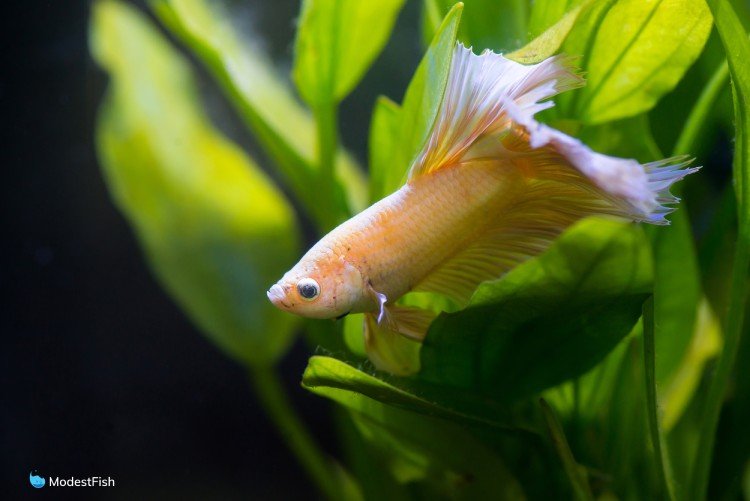
Tank Setup Overview
Tank Supplies
5 Gallon Tank (or more)
Sponge Filter
Heater
LED Lighting
Thermometer
Live Plants
Inert Substrate
Decorations
Water Conditioner
5 gallon bucket
API Master Test Kit
Algae scraper
Gravel vacuum
Diet
Brine shrimp
Bloodworms
Tubifex Worms
Wingless Fruit flies
Fluval Bug Bites
New Life Spectrum Betta
Omega One Betta Buffet Flakes
Table of Contents
Betta Fish Species Profile & Introduction
Bettas (Betta splendens), also called Siamese fighting fish, are native to the Mekong River basin in Southeast Asia. They can be found in Laos, Thailand, Cambodia and Vietnam.
Inhabitting in slow moving waters like swamps, small creeks or even rice paddies. Bettas typically live in what’s called blackwater environments where the water is a dark brown color.
The dark water in blackwater environments is caused by millions of leaves falling into waterways. As the leaves break down, they release tannins (tannic acid). The tannins dye the water dark brown, just like when you add hot water to a tea bag.
If you saw a wild betta, you might not even know it was the same species of fish as the one found in pet stores. Wild bettas have small rounded fins and are a drab greenish brown color.
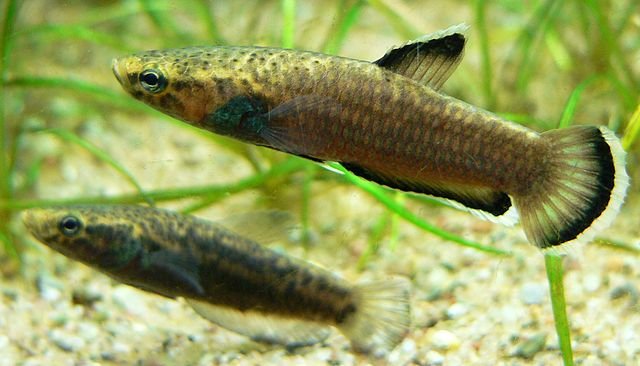
All the spectacular colors and giant fins we’re used to come from many generations of selective breeding.
The somewhat boring colors of the wild fish helps them to blend into their environment and avoid predators.
Bettas are part of the suborder Anabantoidei, commonly known as labyrinth fish. This suborder includes other gourami species like dwarf gouramis, paradise fish and pearl gouramis.
All Anabantoidei have a specialized organ that works like a crude lung, the labyrinth organ. Since they live in oxygen poor environments, they can go to the surface and gulp bubbles of air to breathe using their labyrinth organs.
The labyrinth organ also helps betta fish when they’re in serious trouble. It’s common for wild bettas to end up in small bodies of water that dry up.They can jump out of the water and survive flopping along the ground for short distances to find a new home when needed.
Betta Fish Aquarium Requirements
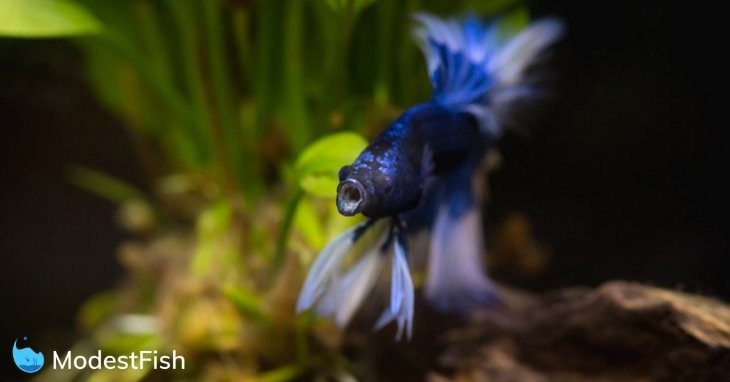
Don’t be fooled by the betta fish in cups at the pet store. Bettas need a much bigger permanent home in order to thrive.
- Tank size: 5 Gallons (or more)
- Filtration: Sponge Filter (Low flow)
- Substrate: Inert Substate (dark substrates make betta fish colors pop)
- Heater: Recommend the Fluval E Series
- Live Plants: Anacharis, Java Fern, Amazon Sword, Java Moss, Anubias, Hornwort, Wisteria, Amazon Frogbit, Hydrophila, Marimo Moss Balls, Betta Bulb
- Decorations: Caves (hiding spots), Driftwood, Indian Almond Leaves
- Maintenance Equipment: Gravel vacuum, 5 gallon bucket, API Master Test Kit, Aquascape tools, Thermometer
Tank Size
The absolute minimum tank size for a betta should be 5 gallons. Yes, I know that you see them in stores being kept in tiny little cups. Yes, tiny, quart-size betta tanks are sold in stores.
Just because the poor fish can survive being kept this way does not mean it’s the right thing to do.
Keeping bettas in tanks under 5 gallons or bowls means they’re being exposed to ammonia as their waste breaks down. It’s impossible to get a healthy nitrogen cycle going in a small, unfiltered tank.
Bettas are really tough and can live for a short time in these conditions. But for them to be happy, healthy and have a normal lifespan, they need more room.
Also, their behavior is much more lively in a larger tank. They swim around and investigate things when they have more room. They’ll even come out to greet you when your face gets near the aquarium.
Substrate
Bettas need an inert substrate. You can use gravel or sand or smooth glass stones, whatever you prefer.
Just avoid aragonite sand. It’s made of calcium carbonate (CaCO3). It will slowly leach both calcium and carbonate into your water, increasing both the general hardness (GH) and carbonate hardness (KH) of the water.
It will also increase the pH.
Bettas need soft, acidic water. So a substrate that constantly increases GH, KH and pH should be avoided.
Just on a personal note, I think that a betta’s colors look nicer against a dark substrate. Seachem and Fluval make excellent substrate suitable for betta fish,
Filtration & The Nitrogen Cycle
Betta fish need a filter for their tanks. You want a filter that’ll give a gentle current in the tank since betta fish are not the strongest of swimmers. A simple sponge or internal filter rated for the size of your tank (GPH 4 x tank size) will do just fine.
After testing different sponge filters, I found UPETTOOLS Biochemical sponge filter to be best for tanks in the 5-10 gallon range. If you’re going above 10 gallons, Hygger’s Double Sponge Filter will be your best choice.
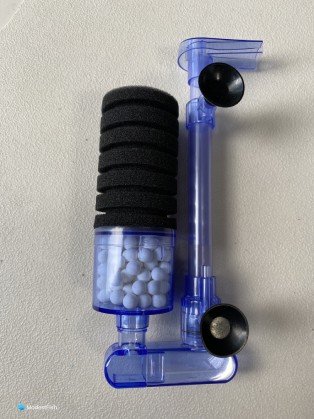
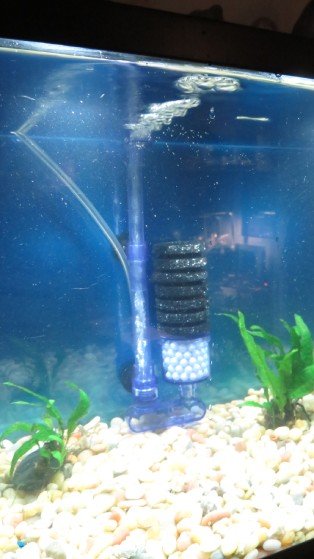
A filter doesn’t just move water around. It provides a home for beneficial bacteria that process fish waste.
It’s a fact, fish constantly pee and poop in the water they swim in. All that waste sinks to the bottom of the tank and starts to break down. This creates ammonia (NH3) that builds up in the water column.
Ammonia is toxic to fish. It chemically burns their gills and the damage done can be permanent. If enough ammonia builds up, the fish will die outright.
Luckily, the beneficial bacteria that colonizes aquarium filters processes ammonia into nitrite (NO2 -1) and then nitrate (NO3-).
Nitrate is much less toxic than ammonia. So it can be allowed to build up in the tank in between weekly water changes.
But, this nifty nitrogen cycle can’t happen in a small stagnant fish bowl. The beneficial bacteria in fish tanks needs oxygen to be able to survive.
Lighting
Betta fish require a consistent dark-light schedule, and the plants in your tank will have lighting requirements,
I recommend you go with the Hygger LED light. It’ll provide more than enough PAR for your typical aquarium plants and allow you to maintain a consistent schedule.
Heater
Betta fish need a heater so their water stays at a steady 75°-81°F (23.8°-27.2°C). I suggest getting a Fluval E series heater rated for your tank size as they have a heater guard, so won’t damage your betta’s fins.
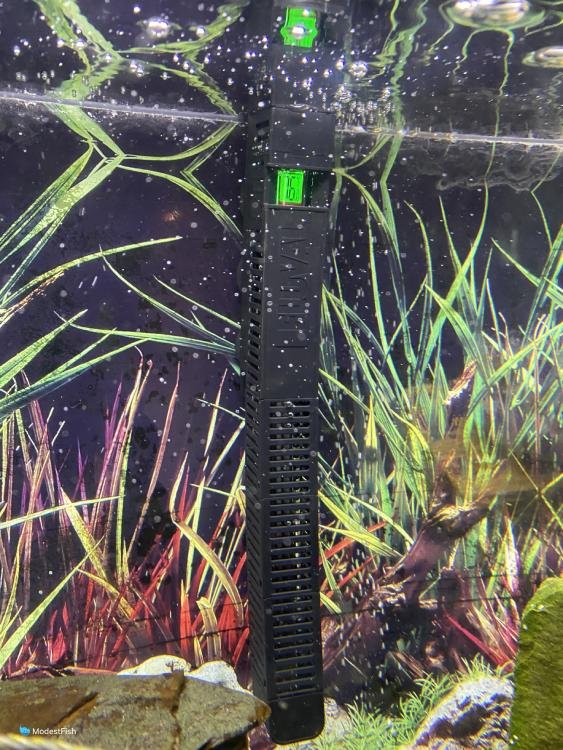
Lids
Bettas are notorious jumpers and require a lid or a mesh cover. Some people have even trained their bettas to jump through hoops.
In the wild, they will jump from puddle to puddle so they can escape poor water conditions or a pool that is drying up.
In aquariums, many betta owners have come home to find their fish on the carpet.
So it’s best to have a tight-fitting lid in case your betta decides he’d like to look around the neighborhood for a new house.
Make sure that you leave at least a half inch gap between the lid and the surface of the water. That way there’s room for the betta to come up to the surface for a breath.
Plants
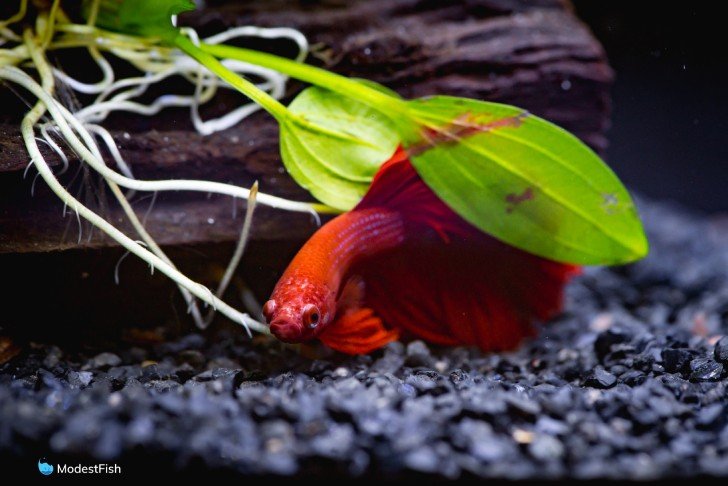
Live plants are a great addition to a betta tank. Java Fern, Anubias, Marimo Moss Balls and Java Moss grow well in small tanks. Floating plants like Frogbit or Dwarf Water Lettuce can discourage jumping.
Plants will provide hiding and resting spots and help remove nitrates from your water column, keeping the parameters stable.
Decorations
It’s best to add decor that gives your betta a few hiding spots. Betta fish love caves and driftwood to hide in.
You might think about adding a betta hammock. They’re little plastic leaves with a suction cup attached, giving them a little perch to snooze on close to the surface of the water.
Just make sure it’s located in calmest spot in the tank so your betta can rest without being disturbed by the current.
I think it’s really neat to see them lounging around. It makes me want to curl up in my own hammock on a sunny afternoon.
Indian Almond Leaves for Betta Tanks
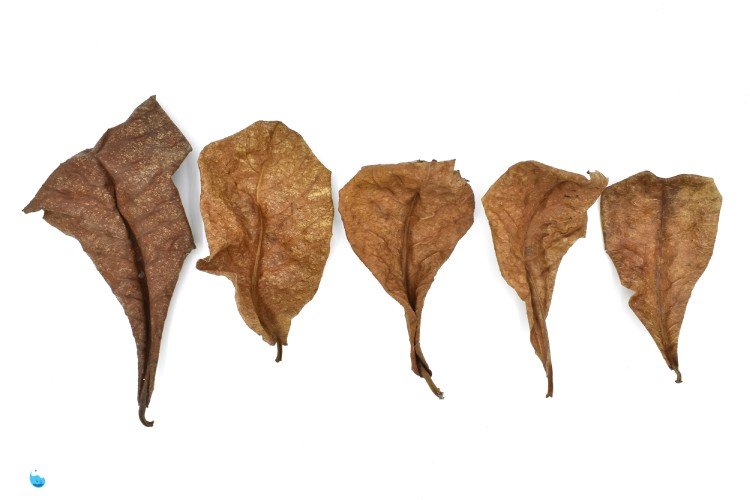
OK so these are not an absolute necessity. But, I really can’t recommend them highly enough. They are a great way to help mimic the natural habitat for betta fish.
Indian almond leaves come from the Terminalia catappa tree, native to tropical regions in Asia.
In Southeast Asia, where most bettas are bred, Indian almond leaf is pretty much universally used as a water conditioner. It is also usually the only treatment used for dealing with sick fish suffering from injuries and/or bacterial infections.
Indian almond leaves leach helpful compounds like tannins, flavonoids and punicalagins which have anti-microbial, anti-inflammatory and antioxidant properties.
These compounds can also help absorb some minerals from the water and lower the pH, making the water softer and more acidic.
The leaves can be left whole or cut into pieces and floated in the tank. They’ll sink after a few days. They break down completely after about a month, leaving only the stem and leaf veins behind. You can just remove the stem and replace with new leaves.
The potency of the leaves can vary, so one leaf for every 2 gallons is a good starting point.
Tannins in the leaves will dye your water somewhat. But the benefits greatly outweigh dealing with tinted water. You can take out leaves and do a water change if the water gets too dark for your taste.
If you don’t like the look of the leaves in the tank, you can make an extract:
Equipment:
- Empty quart jars with lids
- 3-4 Indian almond leaves
- Tea kettle
- Tap water
Steps:
- Place Indian almond leaves in a clean quart jar or other container that can handle boiling water.
- Boil water on the stove.
- Pour water over the leaves to fill the jar. Be careful!
- Let the jar sit uncovered and cool completely.
- After cooling, remove the leaves. The water should be dark brown.
How much to use each week is unfortunately not an exact science. Commercially prepared extracts recommend using one teaspoon per 2 gallons.
Just to be safe, I’d start with half a teaspoon per 2 gallons and increase from there if desired.
Water Parameters for Betta Fish
- Temperature: 75°-81°F (23.8°-27.2°C)
- Ammonia and Nitrite: 0 ppm
- Nitrate: <20 ppm
- GH: 3-4 dGH (50-66.7 ppm)
- KH: 3-5 dKH (53.6- 89.4 ppm)
- pH: 6.5-7.5
Feeding Betta Fish
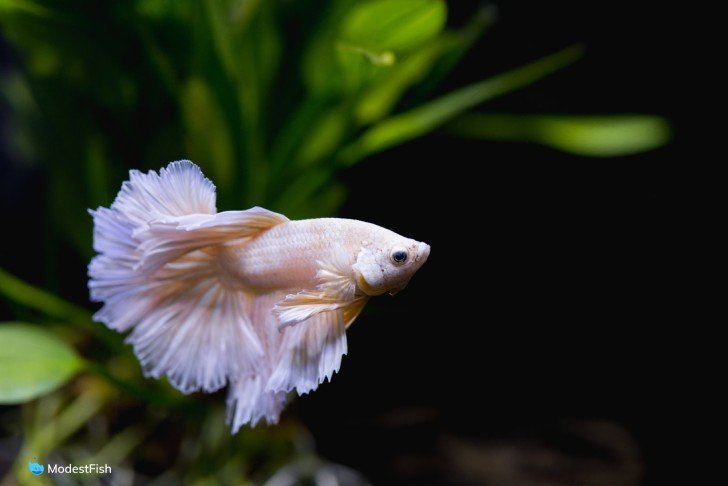
In the wild, betta fish are carniverious insectivores, meaning they eat insects on the water’s surface or larvae swimming in the water column.
In the aquarium, you should look to vary the diet between pellets, frozen, and live foods.
The best foods for bettas are:
- Brine Shrimp
- Blood worms
- Tubifex Worms
- Wingless fruit flies
- Daphina
- Fluval Bug Bites
- New Life Spectrum Betta
- Omega One Betta Buffet Flakes
I recommend feeding a variety of foods throughout the week. I personally like the New Life Spectrum as the stable, and then offer some frozen bloodworms, brine shrimp, daphnia 3-4 times a week.
Rotate a few foods, feeding your betta two small meals per day. Doing one big feed a day can be too much for their digestive system and help avoid overfeeding.
Maintenance Schedule For Betta Fish
Follow this simple schedule to stay on top of your maintenance and keep your betta tank healthy:
- Daily: Morning feed, Evening feed, temperature check
- Weekly: Test for Ammonia, Nitrites, and Nitrates with the API master kit and perform a 25% water change.
- Monthly: Clean any unwanted algae, trim plants, can also rearrange the tank decor to keep your betta stimulated.
To make these easier, I recommend you have the following maintenance tools:
- Gravel vacuum
- 5 gallon bucket
- Water conditioner
- Magnetic algae scrubber
- API Mater Water Test Kit
- Aquascaping tools
- Thermometer
With regards to cleaning the filter, unless you see a real drop off in performance, leave it alone. This is where all the beneficial bacteria in your tank lives and keep the water healthy.
If you find it is getting clogged. Rinse the media using tank water. This will help preserve the beneficial bacteria.
Tank Mates
Tank mates for betta fish can be a difficult subject to approach. There is a reason they’re called Siamese fighting fish. Betta fish are fiercely territorial and tend to kill anything they can get to.
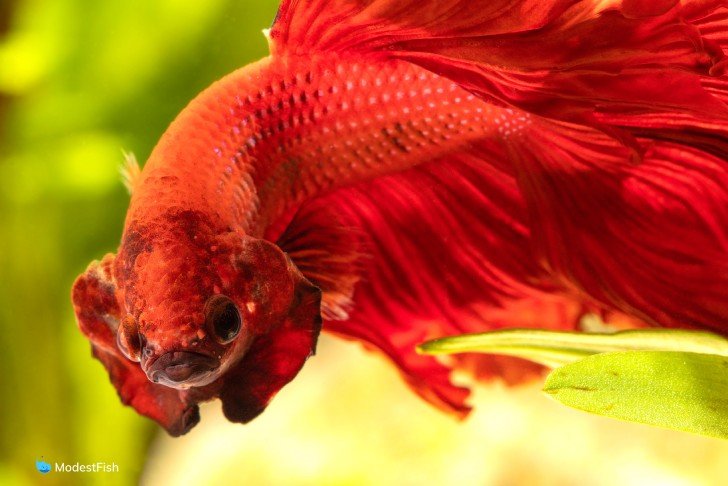
Male betta fish don’t require a tank mate, aren’t sociable and get no benefit from having others in their tank.
If you’re experience, you might get away with some bottom-feeders like bristlenose plecos. But, my advice is to not take any risks.
Female betta are a different story. You can keep multiple of them in a sorority. Which you can read more about in our guide here.
Is a Betta Right for You?
Betta fish really do make great pets. They’re one of my all-time favorites.
They’re beautiful, and given the right conditions, they have great personalities that are really interesting.
I love how they come out to greet you when you get near the aquarium and a healthy male in full regalia is just stunning.
Bettas are hardy little fish, but they still need the same level of care as other species. That means a proper tank, healthy food and regular water changes.
I think that bettas are one of the most mistreated types of fish in the entire aquarium trade.
I don’t think people set out to treat them poorly, but they’re misled by seeing betta fish kept in cups or the tiny betta tanks for sale on the shelves.
I will preach from the mountaintops, or more likely the fish aisle in my local pet store, that these wonderful fish deserve better treatment.
Bettas are gorgeous little spitfires, and with proper care, you can enjoy them for years. I highly recommend them for beginners and seasoned pros alike.

i just rescued a betta and he is already doing much better. he is a crowntail. and in my 5 gal nano with a couple of minnows.
Hi
I’m pejman
Thanks for the information you shared
I am happy to be able to use your information as a novice
Thanks
Thank you for all the info you have researched for us. A pleasure reading it
Thank you for all of your expect advice! It was all very helpful and informative. I am preparing a 9 gallon tank for a beautiful beta and I can’t wait to rescue him from the small cup he is in!
I appreciate learning more & more about betta best care. I was wondering if i could use oak leaf to add tannins to water, or any other than the almond